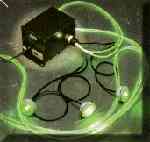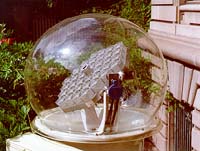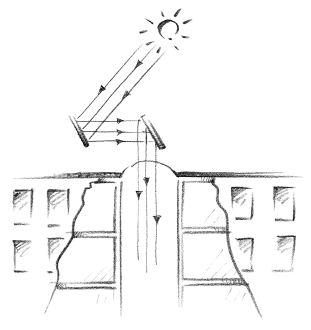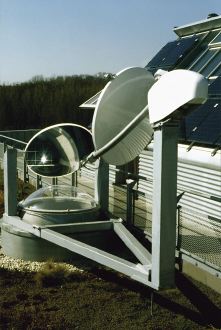 IEA Solar PACES Program Power tower systems Descriptions.
IEA Solar PACES Program Power tower systems Descriptions.

 Go back to Red Rock Energy
Go back to Red Rock Energy
I will be producing solar heliostat arrays this summer that have a peak solar input of about 18KW.
These are mirror devices that reflect sunlight onto a central receiver. Remember the big government solar projects such as "Solar Two" at Daggett, California, approximately 10 miles east of Barstow, California in the Mojave Desert. This system produces about 10MWatts of electricity. Here's an example:
neat Solar Power Tower Systems for Power Generation. Neat picture.
Solar Power Tower Systems for Power Generation. Neat picture.
 IEA Solar PACES Program Power tower systems Descriptions.
IEA Solar PACES Program Power tower systems Descriptions.
This is the National Solar Thermal Test Facility and is operated by Sandia National Laboratories near Albuquerque, NM. This is called the "Power Tower" and it is about 5 MW thermal. And another example:
 Sandia Power Tower aerial view.
Sandia Power Tower aerial view.
This is a proposed heliostat by the Weizmann Institute of Israel.
 Concentrated Sunlight Consortium Weizmann Institute of Science
Concentrated Sunlight Consortium Weizmann Institute of Science
 McDonnell Douglas-Israeli Partnership to Develop Solar Power Plant.
McDonnell Douglas-Israeli Partnership to Develop Solar Power Plant.
Needless to say I don't make anything as large as these. What I do make are cost effective home sized heliostats mounted as a unit. It has 200ft² of mirror area and will provide about a 10 to 1 concentration factor. With this much concentration you get about 18KW solar peak, minus losses, applied to an area of about 2.5ft x 8ft. The receiver and can run at temperatures as high as 600°F or higher. Of course each application will have different temperatures and efficiencies. Just to be safe I only specify a minimum of 10KW thermal peak.
I make heliostat arrays. I don't make receivers. My customers design their own receivers as they are more familiar with their specific needs than I am. I can help in the general design of receivers. This help may include material selection, solar receiver coating recommendations, site selection and safety systems.
My heliostats are designed to be self sufficient. They have a computer that calculates the position of the sun and adjusts the mirrors accordingly.
The computer can move the mirrors in many ways:
| 1. | The computer can act as a thermostat at the receiver to control the process or remove all heat when something goes wrong. |
| 2. | The computer can direct the light to any of several receivers at different times of the day. |
| 3. | The computer can adjust the effective F number to maintain a constant insolation. |
| 4. | The mirror can be adjusted to reflect light in parallel. This light is sent to a parabolic secondary mirror. The resultant concentration factor can be several hundred to one. If the secondary mirror is a section of a torus then multiple heliostat arrays can be concentrated onto a single receiver. |
This is not a price quote. I am only speculating on possible sales prices. My law guy won't let me quote prices yet. I expect to sell our heliostats system at around $10us/ft² of mirror in sizes of around 200ft². Also about $0.20us per installed thermal watt based on 10KW solar thermal output. This then equates to about $2000 per heliostat array. You supply the computer we supply everything else less installation.
For comparison a rule of thumb for PV panels is that they cost about $50us/ft². They then have an installed cost of about $5us per watt not counting the mounts. Of course this is for non tracking panels. Also the wasted energy is not recoverable.
There is plenty enough power to flash water into steam. I'm working on a steam engine to electric power receiver now. I won't be selling this but I do like to find out about the technology. This could be about 20% efficient. If the engine and receiver costs $2000us the total system would now be $4000us. This predicts that electricity would have an installation cost of $2us per watt electric. This system would deliver 1KW of electricity all day and the 9KW thermal waste heat can be stored for domestic heat using hot water.
We can custom make almost any size and any concentration factor you might need. Multiple arrays can work in tandem to multiply the amount of power at a single receiver. Only one computer is needed to run many array units.
The computer is a common IBM PC type. It could even be an old slow 8088. You probably already have one that is not in use. I could supply the computer but that would just increase the cost to you. Besides cheap used computers can be had for around $50. If required I can supply a single board stand alone controller microcomputer these cost about $300 to $400us.
I have been using a Pocket PC from Zeos in the prototype. I also used an 8088 based Compaq laptop. The application simply doesn't require a high powered computer. It does need to have a computer that can use a compiler that uses double precision floating point arithmetic for the solar position calculations. The 8 bit microcontrollers typically don't have enough memory nor have compilers that have double precision floating point math. Even though the calculations are extensive they don't have to be done very often.
I have settled on 200ft² as this size is near my minimum manufacturing cost/ft². If each unit is built larger it needs to be built stronger, read expensive, to resist heavy winds. If built smaller the drive mechanisms become the dominant expense.
The basic engineering design requirements are based on a wind loading of 10lb/ft² from any direction. The minimum safety factor is 8. This makes for a very sturdy and stiff design.
Really low cost manually operated heliostat arrays for the third world are in the works. If the locals build everything and have a village worker do the aiming I think the cost could be as low as $2us/ft² in a 100ft² size. With 9KW peak thermal output it would be easy to do solar cooking and baking. It can also power water desalination and sterilization units.
The mirrors are flat plate glass mirrors. They are each 2.5ft x 8ft in size and 1/8in thick. They are very flexible. To stiffen them I add an aluminum stiffener to the back side. A shaft extends through the ends.
A frame is made to support the mirrors and yet let them rotate about the mirror shaft. In this case I have 10 mirrors in the frame.
front-------------------------------------------------- | | | | | | | | | | | | | --- --- --- --- --- --- --- --- --- --- | || || || || || || || || || || || || || || || || || || || || || || || || || || || || || || || || || || || || || || || || || || || || | --- --- --- --- --- --- --- --- --- --- | | | | | | | | | | | | | --------------------------------------------------side
Up
o
Mirror/ /
/ /
/ /Frame
/ /
/ o
South / / \ North
/ / \
/ / \
/ \
o \
\
Angled Pier\
====================\=====
\
Down
Note! There are a variety of ways this array of heliostats can be used.
| 1. | The mirrors can be adjusted so they are exactly parallel. This sends all the light in a generally parallel beam. This is used to reflect light to a distant parabolic concentrator dish. The dish secondary concentrator can produce temperatures high enough to melt aluminum and possibly steel.
Here are some examples: furnace odeillo |
| 2. | The mirrors can be adjusted so they each reflects light on the same distant area. This adjustment doesn't require extra concentration. Since all 10 mirrors reflect on the same area the basic concentration will be 10 to 1. |
| 3. | lighting Each mirror can be adjusted to reflect light to individual distant locations in diverse directions. This is useful for lighting by sending light into north facing windows. |
Here is an example from professor Cates:
 Hybrid Lighting. By Michael R. Cates.
Hybrid Lighting. By Michael R. Cates.
Lighting and PV electricity.
 EGIS SOLAR TRACKER. Intelligent Sun Tracking Heliostat Systems and heliostat solar illumination.
kuzelka
EGIS SOLAR TRACKER. Intelligent Sun Tracking Heliostat Systems and heliostat solar illumination.
kuzelka I believe this is an example of a Receiver Axis heliostat lighting systems.
I believe this is an example of a Receiver Axis heliostat lighting systems. The German to English translation.
The German to English translation.
A company that sells fiber optic illumination systems:
 SBT Fiber Optic Lighting.
SBT Fiber Optic Lighting.
 Steven Winter Associates
Steven Winter AssociatesHeliobus with 3M Optical Lighting Film (OLF):
 3M heliostat solar illumination. This is an interesting method of sending the light between the floors of a building.
3M heliostat solar illumination. This is an interesting method of sending the light between the floors of a building.
 K. P. Cheung's homepage.
K. P. Cheung's homepage.A company that sells "Passive Through the Roof" solar illumination:
 Solatube Adds A Sunroom Anywhere In The House. The world's original tubular skylight.
Solatube Adds A Sunroom Anywhere In The House. The world's original tubular skylight.
A company that sells "Passive Through the Roof" solar illumination:
 Sun Star, an all natural light that will not increase your electric bill, like traditional skylights.
Sun Star, an all natural light that will not increase your electric bill, like traditional skylights.
(Solatube bought Sun Star.)
A company that sells "Active Through the Roof" solar illumination:
 Quality Lighting, active tracking daylighting system designed to harness the FREE light provided by the sun.
Quality Lighting, active tracking daylighting system designed to harness the FREE light provided by the sun.
 Interferenz™
Interferenz™ The German to English translation.
The German to English translation.
Do you want to grow grass at the ballpark?
 Diamondlights™ in the Bank One Ballpark
Diamondlights™ in the Bank One Ballpark
Heliostat mirrors used to illuminate hard to grow patches of turf.
If a mirror has a width of 2.5ft and the light is sent 115ft the central 2.5ft will be full brightness and decreases to zero at a width of 3.5ft. The halo has a width of .5ft around the central full brightness area. Brightness ranges from full to zero within the halo and is at half brightness at about 3.21ft width.
What does all this mean? It means that if the sunlight is sent a long distance the effective concentration factor is reduced. In the example my 200ft² 10 to 1 heliostat array will have a receiver 3.5ft x 9ft and an effective concentration factor of about 6.3 to 1. Not bad for a simple receiver that is 115 feet away from the mirrors. Of course secondary concentrators can improve this considerably.
My full scale prototype system sends light about 170ft to the north side of a metal pole barn at a height of 10ft above the center of the heliostat array. This heliostat is located approximately 91° west and 45.5° north. The heliostat array is offset to the east by 30ft because of the trees. This location is not ideal but is typical of the compromises needed in real world applications. The simple receiver is about 4ft x 9.5ft with an effective concentration factor of about 5.3 to 1.
plan North
[[[[]]]]Heliostats
Trees <--30ft-->/
^ /
Trees | /
| /
Trees | 170ft
167ft /
West Trees | / East
| /
Trees | /
|/
v
[*]Receiver
South
The whole system uses a computer that controls the movement of the mirrors. Each dimensional parameter is measured carefully and the software moves the mirrors in such a way as to send the light to the receiver. The software operates in "open loop" mode. This means that there is no feedback needed from the receiver. The software calculates to an accuracy of a few arc seconds and the mechanical drivers are good for about 1/10° of arc.
The software first calculates the position of the sun. This program has inputs for longitude, latitude, height above sea level, time, date, barometric pressure, and temperature. This program compensates for all significant errors including the main ones such as atmospheric refraction near the horizon, (called parallax).
I then calculate the half angle between the sun and the receiver. The center mirror is set to a position so that the half angle is perpendicular to the plane of the mirror.
The program also can calculate the position of the moon. When the mirrors are aligned with the moon, at night, the receiver is fairly bright. Its bright enough to do maintenance on the system. Although you have to be careful not to get "moonburn". Its hard to find "MoonTan Lotion" ;^)
 Go back to Red Rock Energy
Go back to Red Rock Energy